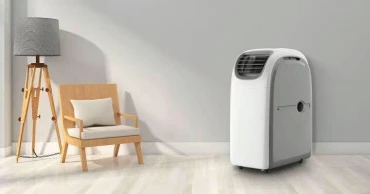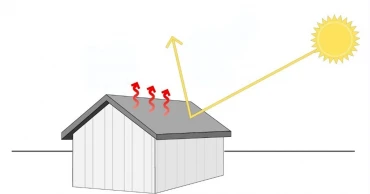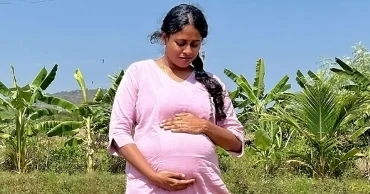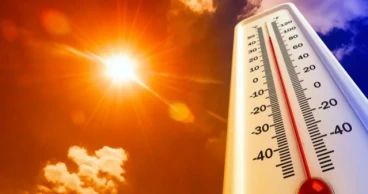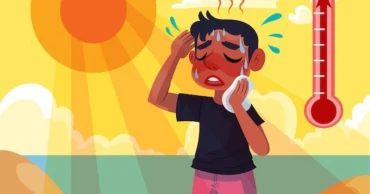heat wave
Heat wave may sweep Bangladesh during Eid celebrations
People in parts of Bangladesh may have to endure extreme heat rather than comfort during tomorrow’s Eid-ul-Fitr celebrations.
“Mild to moderate heat wave is sweeping over Dhaka, Rajshahi and Khulna divisions and Moulvibazar, Rangamati, Barishal & Patukhali districts and it may abate some places,” said a Met office bulletin on Sunday.
Heatwave affects Dhaka, other divisions; temperatures expected to rise
Weather may remain dry with temporary partly cloudy sky over the country, it said.
Day temperature may fall slightly and night temperature may rise slightly over the country.
Country’s highest temperature was recoded at 37.2 Degree Celsius in Ishwardi upazila of Pabna.
9 months ago
No relief in sight during Eid as heat wave continues
The Bangladesh Meteorological Department (BMD) has forecast that the severe to moderate heatwave sweeping over Dhaka and several other districts will continue until Eid-ul-Fitr.
The heat wave situation is expected to remain unchanged for five days, said a BMD bulletin on Saturday
“A severe heat wave is sweeping over Jashore and Sirajganj. A mild to moderate heat wave is sweeping over Dhaka and Barishal, parts of Rajshahi, Khulna, Moulvibazar, Brahmanbaria and Rangamati districts and it may continue,” it said.
Fire Service urges precautions amid earthquake threat after destructive Myanmar quake
Weather may remain dry with temporary partly cloudy sky over the country.
Day temperature may remain nearly unchanged and night temperature may fall slightly over the country.
Country’s highest temperature was recorded in Jashore at 41 degree Celsius on Friday.
9 months ago
Mild heat wave sweeps parts of country: BMD
A mild heat wave is sweeping in different parts of the country and it may continue, said according to Bangladesh Meteorological Department (BMD).
“A mild heat wave is sweeping over the regions of Rajshahi, Rangamati, Feni, Sitakunda, Jashore, Bagerhat and Patuakhali and it may continue.
Weather may remain dry with temporary partly cloudy sky over the country.
Day and night temperature may rise slightly over the country.
9 months ago
Portable AC Buyer’s Guide for 2024: Everything You Need to Know
In this unbearable summer heat, air conditioners are a lifesaver. However, most air conditioners come as fixed units. Some are central AC units which can be quite expensive to install. So what do you get if you want a portable option? Well, look no further than portable air conditioners. Unlike fixed units, portable ACs can be moved around from one place to another depending on their type. It's effective, saves cost, and doesn’t require additional fittings. Here’s everything you need to know about portable ACs, their types, and the best options out in the market.
How Does Portable AC Work?
Portable AC works on the basic principles of fixed AC units. The difference is that some portable AC units aren’t dependent on an outdoor unit. Others don’t require a drip hose or tray. Some portable ACs are essentially self-fulfilling units.
A portable has the following components:
- Compressor - Evaporator Coil and Refrigerant - Condenser Coil - Fan
The evaporator coil and refrigerant work to cool the air while the compressor triggers the refrigerant for the cooling process. The fan moves around to disperse the cool air. On the other hand, the condenser coil cools down the refrigerant. Depending on the type, the drip water either goes out through the hose, collects in the tray, or gets evaporated.
Read more: Strategies for Cooling Your Roof During Intense Summer Heat
Types of Portable AC
There are mainly three types of portable AC. They are:
Monoblock Type AC Units
Monoblock-type AC units are further classified into two types:
Single Hose Portable AC
As the name suggests, single-hose portable AC uses a unitary hose to intake and exhaust air into the unit. This type of unit is less costly compared to the double hose units but is also less efficient. The operational noise however is very low with surrounding noise reaching up to 60 dB max.
Double Hose Portable AC
The double-hose portable AC has two different hoses for intake and exhaust. Compared to single-hose units, these ACs are less mobile. However, the dual hose system allows for efficient and fast cooling.
Split Portable AC
Split portable AC works similar to the monoblock ACs. However, unlike the single-unit structure of the monoblock, split AC has two separate components. The condensing unit is installed outside whereas the portable ventilation unit is placed inside. A hose connects both units.
The only advantage of split ACs is that they are less bulky and easy to move around within a small area. They are also less noisy compared to the monoblock units.
Self-evaporating Portable AC
Self-evaporating portable ACs are truly self-sustaining units. These types of ACs release the hot air and the moisture directly from the unit within the room. As a result, there is no need for a drip tray or an external hose.
These AC units are much smaller compared to the other types making them suitable for small space and personal use.
Read more: Mist Fan Buyer Guide and Price Ranges in Bangladesh for 2024
What to Consider Before Buying a Portable AC?
So you’re in the market for a portable AC. Given the different types and sizes, the choice of ACs can become confusing. Here’s a list of things to keep an eye out for.
Size of the Room
The size of the room is the first thing you should consider before getting a portable AC unit. Portable ACs need to be matched with the size of the room to get the optimum performance. For example, a unit with low tonnage in a large room will not be able to cool the room. On the other hand, a higher tonnage unit in a small room will repeatedly cycle on and off.
BTU Rating
BTU or British Thermal Unit is the unit of cooling capacity for AC units. You can consult with AC experts to get the correct size of AC unit for your space.
Energy Efficiency
Energy efficiency is a key aspect to consider as AC units may rack up your electricity bills. Look for AC units with an Energy Efficiency Ratio or EER certification. A higher EER indicates a higher level of energy efficiency which will save you utilities in the long run. You can also consider energy star-rated units for higher energy savings.
Read more: IPS Buyer's Guide with Price Ranges in Bangladesh
Exhaust Vent Options
There are mainly two options – single hose or dual hose for exhaust venting. Dual hose options are more efficient compared to single hose options. However, the higher efficiency comes at the cost of reduced mobility. Single hose options can be a good choice for smaller rooms whereas dual hose units are better suited for larger ones.
Portability
If absolute portability is what you’re looking for, then consider getting the self-evaporating type AC units. These are best suited for smaller rooms and can be easily moved around as long as there’s a power outlet connected to it.
On the other hand, single-hose, dual-hose, or split-type units will offer limited mobility but better efficiency in usage.
Noise Level
Portable AC units tend to be louder compared to the standard traditional units. Most fixed units range between 30 to 40 dB sound whereas portable units may range anywhere between 60 to 80 dB.
If you want reduced noise, consider opting for a split-type AC unit.
Read more: Home Air Conditioner Buyer Guide 2024: Everything You Need to Know
Best Portable AC Units Available in Bangladesh in 2024
Under 50,000 BDT
Chigo 1.25 Ton Accurate Sensor Portable Air Conditioner
The Chigo 1.25-ton Portable AC’s single hose unit is designed to maximize the output for smaller areas. The AC comes with several intelligent features like auto operation, auto restart, comfort cooling as well as a sleep timer. The sleep timer helps to manage the usage as this is a non-inverter AC.
Key Features
- Uses R-32 Refrigerant - Operating range between 20 to 43 degree Celsius - Copper tube condenser with golden fin - Rotary-type compressor - The four-side automatic fan movement - Self-diagnostic options - Best suited for 100 to 120 sq. ft. rooms - The current price of Chigo 1.25 ton portable AC is 40,500 BDT.
Midea MWF-12CMP 1-Ton Portable AC
The Midea 1-ton portable AC is designed for personal use. This is a single-hose portable unit that is compact and can be easily moved around in a small space. Even though it is a non-inverter model, it has several intelligent features to save energy and provide efficient output.
Key Features
- All-in-one cooling, heating, and dry fan option - LED display for thermostat management - Four-side auto swing mechanism - Uses R-410A refrigerant - Operational temperature between 17 to 35 degrees Celsius - Rotary-type GMCC compressor - 1.2L/hr moisture removal- 46 dB noise level at the highest mode - Best suited for 80 to 120 sq. ft. rooms - The current price of Midea MWF-12CMP 1-Ton Portable AC is 39,500 BDT.
Gree GP-12LF 1-Ton Portable Air Conditioner
Gree GP-12LF 1-Ton portable AC can be another single-hose option for personal use. This non-inverter type AC has a 24-hour programmable timer to set the limit according to usage. It also comes with 2.78 EER suggesting a high energy efficiency capability.
Key Features
- Turbo and max mode for cooling - Uses R-410A refrigerant - Up and downswing flap with control option - Auto cleaning filter - LED display for timer and thermostat control - Low voltage startup - Anti-cool wind feature - The current price of the Gree GP-12LF 1-Ton Portable Air Conditioner is 42,000 BDT.
Read more: Tips to Keep Home Cool in Summer Without AC
Under 1 Lac BDT
DeLonghi Portable Air Conditioner WE18INV
DeLonghi, the ultra-popular espresso coffee maker brand also makes portable air conditioners. They even have an entire range of home appliances ranging from kitchen to home comfort line.
The WE18INV is their 1.5-ton portable air conditioner with a turbo cooling option. In addition to being a portable AC unit, it also works as a dehumidifier and air freshener.
Key Features
- Uses R-410A refrigerant - Water-to-air cooling technology - 10 L water tank capacity - Single hose exhaust vent - 3-speed fan mode - 55 dB noise level in standard operation - Two years of compressor, parts, and service warranty- The current price of the DeLonghi WE18INV portable air conditioner is 73,500 BDT.
Carrier Mobile Air Conditioner
Carrier is another reputable brand in the air conditioner market of Bangladesh. The mobile air conditioner is part of their portable AC unit lineup offering cutting-edge features at a bargain price. The 51QPD012N7S has a 13,000 BTU rating making it ideal for 120 to 150 sq. ft. size rooms.
Key Features
- Uses R290 refrigerant - EER rating of 2.6 - Built-in LED display - 3-speed fan mode - Automatic restart option - Timer and sleep mode - 51 to 52 dB of operational noise - The current price of the Carrier mobile air conditioner is 54,000 BDT.
Under 1.5 Lac BDT
Midea MGFA-60CR 5-Ton Floor Stand Non-Inverter AC
The Midea 5-ton stand AC is one of the largest portable ACs available in the Bangladeshi market. It is best suited for large commercial spaces ranging between 2400 to 3000 sq. ft. The MGFA-60CR is a split system portable AC with a stacked outdoor unit and a standing indoor unit. The AC uses a single hose vent for exhaust and air intake.
Key Features
- Rated at 60,000 BTU - Uses R-32 refrigerant - Operational temperature ranges between 20 to 43 degrees Celcius- Energy class rating if A+/A++- 3-mode fan speed - 4-side auto swing - 58 dB indoors and 70 dB outdoors operational sound - Uses a copper tube condenser with a golden fin - Sleep, Turbo, Eco, Dry, and Fan modes. - The current price of a Midea 5-ton non-inverter floor stand AC is 122,000 BDT.
Final Words
Portable AC units are less common compared to traditional fixed AC units. But given the innovation and usability it brings, they are increasingly becoming popular among the new generation of users. It is recommended to check for the space compatibility and usage scenario before opting for a portable AC unit.
Read more: 10 ways to reduce your AC power consumption and lower electricity bill this summer
1 year ago
Strategies for Cooling Your Roof During Intense Summer Heat
As summer temperatures soar, the heat can make indoor living conditions uncomfortable, particularly for those living on upper floors. The roof, directly exposed to the sun, plays a significant role in how heat affects the home. However, there are multiple strategies homeowners can implement to keep their roofs and homes cooler during intense heat waves.
Tips to Keep Your Roof Cool During the Scorching Heat of Summer
Selecting Appropriate Roofing Materials
Choosing the right roofing materials is crucial in climates that experience intense summer heat, like Bangladesh. Materials that reflect solar energy rather than absorb it, such as metal, tiles, or specially designed reflective shingles, can significantly reduce heat absorption. These materials help maintain lower roof temperatures, which translates into cooler indoor environments.
Utilizing Cool Roof Coatings
Cool roof coatings are designed to reflect more sunlight and absorb less heat than standard roof surfaces. Applying these coatings can lower roof surface temperature dramatically, reducing heat transferred into the home and prolonging the lifespan of the roofing materials. These reflective coatings are an effective solution for homeowners looking to retrofit existing roofs without complete replacement.
Read more: Tips to Keep Home Cool in Summer Without AC
Enhancing Insulation
Insulation plays a critical role in minimizing heat transfer from the roof to the home's interior. Effective attic or roof space insulation, using materials such as fiberglass, foam board, or cellulose, acts as a thermal barrier. This barrier helps stabilize indoor temperatures, making homes more comfortable during both day and night.
1 year ago
Heatwave forces closure of schools until Thursday
Due to the ongoing severe heatwave, the Ministry of Primary and Mass Education has announced the closure of all government primary schools, child welfare trust schools, and learning centers under the education bureau until Thursday.
Senior Information Officer of the ministry, Mahbubur Rahman Tuhin, signed the notification on Monday, emphasising that the decision was made to ensure the health and safety of children.
Additionally, educational activities at all institutions below the secondary level and vocational educational institutions in Dhaka, Chuadanga, Jashore, Khulna, and Rajshahi districts were suspended for Monday.
Guidelines issued for primary schools reopening tomorrow amid heatwave
A separate notice from the Education Ministry, signed by MA Khayer, public relations officer, was issued on Sunday following consultations with the Health Ministry and the Bangladesh Meteorological Department.
However, educational institutions equipped with air conditioning were allowed to remain open. Despite the ongoing heatwave, which began in the first week of April, schools and colleges had initially resumed classes on Sunday after the Eid-ul-Fitr holidays and their subsequent extension due to the heat.
Primary schools conducted classes on Monday since no directive had been issued by the concerned authorities until Sunday night. This reopening came even though there has been no significant relief from the heatwave, raising concerns among parents, particularly those with young children.
Heat wave: Assembly at all govt primary schools suspended
Originally, schools and colleges were set to reopen on April 21 after the Eid holidays, but the persistent extreme temperatures prompted authorities to extend the closure until April 27. The Ministry has advised parents and guardians to stay informed through official updates as the situation develops.
1 year ago
Navigating the Risks of Summer Heat: Essential Health Tips for Pregnant Women
Summer is a time of heat and outdoor activities, but for pregnant women, it also brings the challenge of coping with intense heat waves that can pose serious health risks. From dehydration to heatstroke, the heightened vulnerability of expectant mothers requires careful strategies to ensure their health and that of their developing babies. This comprehensive guide explores practical and effective measures to safeguard pregnant women during these critical months.
Understanding the Risks for Pregnant Women in Summer
Pregnancy demands a lot from the body, which is already managing increased blood volume and the energy requirements of carrying a baby. In the summer, these challenges are compounded by higher temperatures and humidity, which can lead to faster dehydration and overheating. This increased susceptibility makes it essential to adopt preventive measures against heat-related health issues.
Hydration: The First Line of Defense Against Heat
Water is a vital ally for pregnant women during hot weather. Staying well-hydrated is crucial, as dehydration can trigger complications such as overheating, urinary tract infections, and even preterm labor. At least 8-10 glasses of water daily are recommended. Using a reusable water bottle makes it easier to stay hydrated on the go.
Read more: How to Travel Safely During Heat Waves
Electrolyte Management
Alongside hydration, maintaining electrolyte balance is critical. Loss of electrolytes through sweating can be significant in summer. Electrolyte-rich drinks or adding a pinch of salt to water can help restore balance.
Natural sources such as coconut water are also beneficial. It is important to check with a healthcare provider before incorporating new items into the diet, particularly if there are underlying health conditions.
Choosing the Right Clothing
Appropriate attire can significantly influence body temperature. Pregnant women should opt for loose, lightweight, and breathable clothing. Fabrics like cotton and linen are ideal as they allow air circulation and help prevent overheating.
Read more: Summer Tips for School-going Children
Light colors are preferable because they reflect sunlight, whereas dark colors absorb it, increasing heat retention. Comfortable, well-fitting shoes are also essential to accommodate swelling in the feet, a common issue during pregnancy.
Sun Protection Strategies
Sun protection is vital for preventing skin damage and managing body temperature. A wide-brimmed hat, UV-protective sunglasses, and sunscreen with at least SPF 30 are key to guarding against the harmful effects of UV radiation.
Limiting Exposure to Extreme Heat
It is advisable for pregnant women to minimize their time spent outdoors during peak heat hours—typically between 10 am and 4 pm. Planning activities during cooler parts of the day, such as early morning or late evening, can reduce the risk of overheating. When outside, staying in shaded areas or using an umbrella can provide immediate relief from direct sunlight.
Read more: How to Protect Outdoor Workers from Heat Stroke
1 year ago
Two teachers die from ‘heat stroke’ amid ongoing countrywide heat wave
Two teachers died possibly from ‘heat stroke’ in Chattogram and Jashore districts on Sunday (April 28, 2024) morning when sever heat wave is scorching the country.
In Chattogram, madasha teacher Maulana Md. Mostak Ahmed Kutubi Alkaderi, 55, fell unconscious while going to his workplacefrom his home in the Mohra area of Chandgaon.
Kutubi Alkaderi, son of late Khalilur Rahman of Kutubdia Lemshikhali in Cox's Bazar district and father of two sons and one daughter, used to work at Khitapchar Azizia Mabudia Alim Madrasha in Boalkhali upazila of Chattogram.
Woman, 2 children electrocuted in Barishal
Witnesses said when the madrasha teacher boarded the ferry at Kalurghat around 9am suddenly he collapsed.
Later, he was taken to Chattogram Medical College Hospital (CMCH) where doctors declared him dead.
In Jashore, Ahsan Habib, an assistant teacher of Ahmedabad High School, died from apparent heat stroke on Sunday in sadar upazila.
AZM Parvez Masud, headmaster of the school, said Habib fell sick around 9 am when he went to school after working in a field.
Two children drown in Rajshahi pond
Later, he was taken to Jashore General Hospital, where a doctor declared him dead.
The body was kept at Jashore General Hospital morgue for autopsy, said Abdur Razzak, officer-in-charge of Jashore Kotwali Police Station.
The reason behind the death will be known after autopsy, he said.
1 year ago
How to Travel Safely During Heat Waves
Summer vacation presents a wonderful opportunity to explore new destinations. However, during the warmer months, soaring temperatures necessitate careful planning to ensure health safety, especially as many people travel for work, medical treatment, or personal reasons. Here are some effective tips for traveling safely during summer heat waves.
Health Risks During Extreme Heat Waves
Heat waves bring a range of health risks, from mild heat cramps and exhaustion to severe, potentially life-threatening heatstroke. Prolonged exposure to high temperatures can lead to dehydration and heat exhaustion, particularly affecting vulnerable groups such as the elderly, children, pregnant women, and those with pre-existing medical conditions.
Recognizing the signs of heat-related illnesses is crucial. Symptoms may include headaches, dizziness, excessive sweating, weakness, nausea, and a rapid heartbeat. If you or someone you are traveling with experiences these symptoms, it's important to seek shade, rest, and rehydrate immediately. In severe cases, medical attention should be sought promptly.
Read more: Summer Tips for School-going Children
How to Stay Safe While Traveling During the Scorching Heat of Summer
Planning Ahead
Before embarking on your summer travels, careful planning is necessary. Check the weather forecast for your destination and schedule activities during the cooler parts of the day, typically early mornings and evenings. Be aware of any heat advisories or warnings and adjust your plans accordingly. Consider whether your accommodation has air conditioning, which can be crucial during heat waves.
Dress Appropriately
Opt for lightweight, loose-fitting clothing made from breathable fabrics like cotton or linen. Light colors, such as white or pastels, reflect sunlight and help keep you cool. Moisture-wicking garments can also reduce sweat and discomfort.
Read more: Summer Drinks: Refreshing Homemade Sherbets to Beat the Heat
Stay Hydrated
Water is vital in the heat. To combat dehydration, a common risk during hot weather, drink plenty of fluids. Carry a refillable water bottle and drink regularly, even if you don’t feel thirsty. Avoid sugary or caffeinated beverages, as they can lead to further dehydration.
1 year ago
Summer Tips for School-going Children
As the summer heatwave continues, the risk of heat exhaustion and dehydration becomes a concern. Like adults, children can suffer from severe heat-related illnesses. Therefore, parents and caregivers should be cautious, especially for school-going children who stay outside the home for hours. Here are some essential summer tips to ensure the well-being of school-going children during the hot months.
How to Keep School-going Children Healthy During Summer Heat Waves
Stay Hydrated
Ensuring children stay hydrated is crucial during a heatwave. Parents and caregivers should encourage children to drink plenty of fluids throughout the day, focusing on water as the primary source of hydration. It would be wise to avoid serving children sugary or caffeinated beverages that can contribute to dehydration.
While leaving for school, it is necessary to provide children water bottles and remind them to take regular sips, even if they are not feeling thirsty. Offer water-rich fruits and vegetables like watermelon, cucumber, and oranges as healthy snacks to help keep children hydrated.
Read more: How to Protect Outdoor Workers from Heat Stroke
Dress Appropriately
Lightweight, loose-fitting clothing of breathable fabrics like cotton or linen can help children stay cool. It is highly recommended to opt for light-coloured clothes that reflect sunlight rather than dark colours that absorb heat.
Furthermore, while staying outdoors children can wear wide-brimmed hats and sunglasses to protect their faces and eyes from the sun's harmful rays.
Seek Shade
Children might need to stay outdoors for diverse purposes, like waiting for a school bus. During such situations, children should be encouraged to seek shade or canopies to minimise direct exposure to the sun.
Read more: How to Protect Your Skin and Hair from Sun Damage
Apply Sunscreen Liberally
Sunscreen application is another crucial aspect of sun protection. Like adults, children can use broad-spectrum sunscreen with a high SPF (Sun Protection Factor) of at least 30. Before going to school or other places, kids need to apply sunscreens generously to their exposed skin, including the face, neck, arms, and legs. Nowadays many reputed brands produce child-friendly sunscreen products.
Sunscreen should be reapplied every two hours, or more frequently if children are swimming or sweating heavily. Parents and caregivers should teach children how to apply sunscreen properly and encourage them to build their sun protection routine.
Plan Outdoor Activities Wisely
While planning schedules for active outdoor games and sports during the warmer months, parents should pay attention to the matter that children stay safe from overheating or sunburn. However, when planning outdoor activities, it's essential to schedule them during the cooler parts of the day, such as early morning or late afternoon, to avoid the peak heat hours.
Read more: Summer Drinks: Refreshing Homemade Sherbets to Beat the Heat
Caregivers should guide children to play in shaded areas, such as parks with plenty of trees, or bring portable shade structures like pop-up tents or sun umbrellas to prevent sunburn and heat-related illnesses.
While playing, sweat should be wiped off immediately. Additionally, encouraging regular play breaks in shaded areas allows children to rest and hydrate. It is essential to prevent heat-related illnesses.
Stay Indoors During Peak Heat
During extreme heat, it is best to stay indoors in air-conditioned or well-ventilated spaces for children to avoid heat-related illnesses. It would be thoughtful for the parents and caregivers to plan indoor activities like board games, arts and crafts, or movie marathons to keep children entertained and safe from the heat.
Read more: Beat Dehydration with These Summer Vegetables
Educate About Heat-Related Illnesses
It is essential to teach children about the signs and symptoms of heat-related illnesses, such as heat exhaustion, heatstroke, dizziness, nausea, rapid heartbeat, etc.
Parents and caregivers should teach children to speak up if they are feeling unwell and remind them of the importance of seeking help from a trusted adult if they experience any symptoms of heat-related illness.
Use Cooling Strategies
Implementing cooling strategies like taking cool showers or baths, using fans or air conditioning, and applying cold compresses to the skin can help children beat the heat and stay comfortable indoors.
Read more: Heat Stroke Prevention: Best foods, drinks to avoid heat exhaustion
Parents and caregivers can freeze damp washcloths or water bottles and place them on pulse points like the wrists, neck, and temples to help lower the body temperature of the children. It can make their mind and body cool after returning home from school or outdoors during the heat waves.
Regular Baths
Bathing plays a vital role in maintaining cleanliness. It is important to avoid allowing children to drink or bathe in ice-cold water during hot weather. Instead, offer them water at room temperature or slightly cool.
When bathing, use water at a comfortable temperature, neither too hot nor too cold, to avoid shocking their system.
Read more: Heat Stroke: Symptoms, First Aid, and Prevention
Stay Connected
Staying connected with children, caregivers, and school staff during a heatwave is essential for assuring everyone's safety. Keep lines of communication open with children, caregivers, and school staff during summer.
Sharing information about heat safety tips and encouraging everyone to look out for each other helps create a supportive environment where everyone can stay cool, hydrated, and healthy during hot weather.
Thus, parents and caregivers can minimise the risk of heat-related illnesses in children at home, community space, school, playground, or other places.
Read more: Guidelines issued for primary schools reopening tomorrow amid heatwave
Bottom Lines
Implementing summer safety for school-going children during a heatwave is paramount to their well-being and health. Parents, caregivers, and school staff can help mitigate the risks associated with hot weather, by prioritising hydration, sun protection, appropriate clothing, and staying cool indoors during peak heat hours.
Educating children about heat-related illnesses and empowering them to recognise signs of distress is equally important. By working together and staying aware, the wellbeing and health safety of school children can be assured during the summer months.
Read more: Mist Fan Buyer Guide and Price Ranges in Bangladesh for 2024
1 year ago



